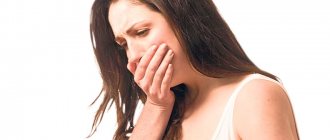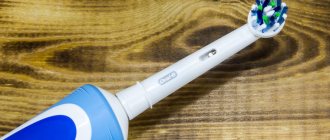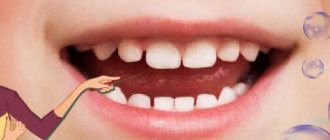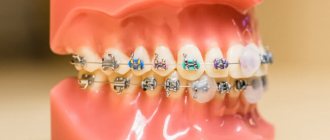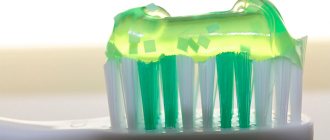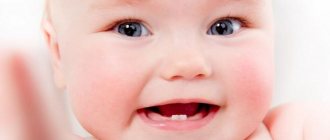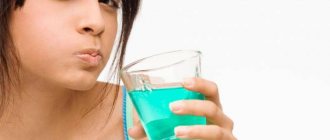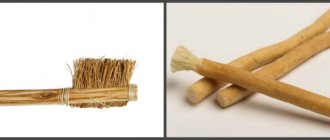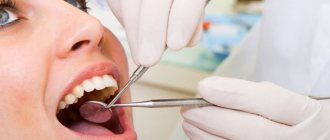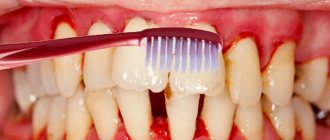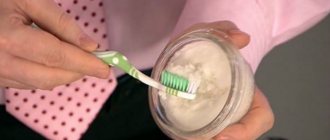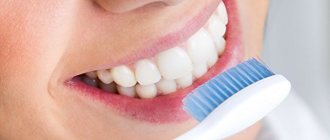Why should children brush their teeth?
Daily brushing of teeth is an integral part of our lives and allows us to keep our teeth healthy.
This must be instilled in your children. Teaching a child to brush their teeth from early childhood is easier than forcing them to do it at school age. Note: If before the baby was born in the family, parents brushed their teeth as they wanted and when they wanted, then while teaching the child to brush their teeth, they should also learn to brush their teeth correctly themselves. After all, children are a reflection of their parents and try to imitate them.
The difference in cleaning is one and a half years and over two years
For children under one and a half years old, it is advisable to brush their teeth several times after each meal, and then twice a day in the morning and evening.
Starting from the age of two, a child’s desire for independence awakens. At this age, the baby tries to do everything himself. A child may even be angry, offended by adults and forbid them to brush his teeth, but it is important to convince the child to do this together with his parents and under their control. It is necessary to teach the baby to maneuver his hand, and also explain to him why it is necessary to brush his teeth and what happens if this is not done.
At what age should a child brush his teeth?
You should start brushing your baby's teeth as soon as they appear. Each baby’s first tooth erupts differently - maybe at 4-5 months, or maybe by 8-9 months (“Teeting in children: symptoms and what to do”).
First, this can be done with a special silicone finger brush. To do this, the brush is placed on the adult’s finger and the mother or father cleans the baby’s oral cavity with massaging movements. There is no need to use paste.
Finger toothbrush
How to brush your baby's teeth with a silicone brush
Important! You should brush your baby’s teeth very carefully, without pressing, as young children’s gums are very sensitive and can be damaged by sudden careless movements.
By about 10-12 months, you can already buy a small toothbrush for your baby. The bristles of such a brush should be soft and elastic, and the surface of the brush head should not cover more than two teeth. As a rule, such brushes have a thick non-slip handle or stopper, are made in the form of animals, cartoon characters, with a rattle, backlit, etc.
Children's brush for children up to 2 years old
Illuminated toothbrushes
Children's toothbrush with stopper
Note: The bright design of toothbrushes and all kinds of “decorations” interest the child, which makes it easier to accustom him to oral hygiene.
First tooth - first brush
According to dentists, you should start brushing your teeth as soon as they appear.
At first, you can clean your teeth with a piece of damp gauze or a cotton swab, placing your baby on your lap.
A more modern, but also expensive analogue is disposable wet wipes made in the shape of a fingertip.
Dental wipes are recommended to be used during the first six months.
From the age of three to four months to one year, while the baby has not yet acquired all the milk teeth, a silicone finger brush is ideal for him. The device is designed specifically for comfortable and safe care of children's oral cavity.
The brush is placed on the finger of an adult, who, with careful and smooth movements, cleans the baby’s first teeth of plaque from plaque. The silicone brush simultaneously massages the gums, relieving itching during teething. The fingertip is easy to clean and suitable for reusable use.
Although many manufacturers limit the service life of the brush to one year (sometimes longer), it must be changed every 2-3 months.
How to properly brush children's teeth
When the baby learns to hold a toothbrush and understands what it is for and how to use it, and this is approximately 2-3 years old, it is necessary to teach him how to care for the oral cavity and brush his teeth on his own. It is important to let the child feel how this happens. It is necessary for the child to brush his own teeth. After this, parents should brush their children's teeth again.
Child brushes his teeth himself
Both baby and permanent teeth (“Eruption of permanent teeth in children, symptoms of eruption of permanent teeth”) need to not only be brushed, but brushed correctly. It is worth noting that the rules for brushing teeth, the order and time of brushing are the same for both children and adults.
To teach a child to brush his teeth correctly, it is necessary to monitor his compliance with the following rules:
- It is important to hold the toothbrush correctly when brushing your teeth - at an angle of approximately 45 degrees relative to the gums;
- the amount of toothpaste is about the size of a grain of rice, after 3 years – about the size of a pea. It is worth noting that a larger amount will interfere with cleaning due to foam;
- The upper teeth should be cleaned using sweeping movements from top to bottom;
- lower teeth should be brushed from bottom to top;
- thoroughly clean both the external and internal surfaces of the teeth;
- thoroughly clean the chewing surfaces of the teeth;
- the surface of the teeth must be brushed back and forth from above and below;
- It is also necessary to clean the surface of the tongue from plaque - as a rule, there is a special grooved surface on the back of the brush head.
Important! You should not completely entrust this process to your baby, as many children are in a hurry and do not brush their teeth thoroughly. Therefore, the entire process must be monitored and, if necessary, given hints to the child. This should be done until 7-8 years of age, or even longer.
Children's toothbrushes
As the child grows, the toothbrush should also “grow” and meet the baby’s needs. Currently, you can buy a toothbrush for any age in specialized stores.
Children's toothbrushes
Electric toothbrushes are also produced for children, but the impact on children's teeth is undesirable, since an electric brush can damage immature enamel.
Important! You don't only need to change your toothbrush as you get older. It is necessary to buy a new brush at least once every three months. In other words, a new brush for every season.
What toothpaste should I use to brush my child's teeth?
The child's teeth are brushed only with a special children's toothpaste. Currently, there are many types of such pastes. When choosing, you should pay attention to:
- safety - the packaging must bear the StAR mark (Russian Dental Association);
StAR mark
- recommendations from a pediatric dentist;
- consistency – the paste should not contain any hard ingredients;
- fluoride content – children should not use pastes with a high fluoride content when brushing their teeth;
- pleasant taste and aroma.
Note: We can say that all toothpastes for children are edible. If a child eats it in small quantities, then nothing bad will happen to him.
Teeth Brushing Procedure
Brushing procedure
The procedure for brushing teeth in children is as follows:
- rinse your mouth with plain water;
- apply the brush to the teeth at an angle of 45 degrees;
- Using circular movements, gently but thoroughly clean the chewing surface;
- connect the jaws and brush the outside of the upper and lower teeth;
- open your mouth and brush the inside of all teeth;
- Rinse your mouth with water several times.
Note: After brushing, make sure your child spits out the toothpaste and rinses his mouth.
How long to brush children's teeth
You need to brush your teeth twice a day - morning and evening, and also, if necessary, during the day after meals. In this case, the time for one cleaning should be at least 2-3 minutes, but no more than 4 minutes.
Important! You should not brush your teeth for a long time, as such exposure can lead to thinning of the enamel and, consequently, to increased sensitivity.
You need to brush your teeth correctly
It is best to brush your child's teeth while standing behind him.
Hygiene should be a joy for the baby, so it’s better to combine it with play, while making up stories about where the brush is a magic machine and the mouth is a garage.
Another version of the game is cleaning a room, each element of which must be thoroughly cleaned.
You can also sing a song or read poems about how useful and important brushing your teeth is.
You should start with the chewing teeth, moving in a circular motion to the front teeth. You should try to place the brush on the gum at an angle of 45 degrees to the base of the crown, thereby effectively cleaning the enamel surface and massaging the gum.
After brushing your teeth, it is important not to forget about your tongue, which you also need to brush over 2-3 times. At the end of the procedure, you need to rinse your mouth with warm boiled water and spit.
Child does not want to brush teeth
Unfortunately, many parents are faced with the fact that their children do not like to brush their teeth for some reason (sensitive gums, etc.) and try in every possible way to avoid this process.
To get your child used to brushing their teeth regularly, you can:
- show the process with a personal example;
- change toothpaste and brush, and it is important to entrust the choice to the baby;
- during the cleaning process, sing songs to the baby or recite rhymes and nursery rhymes;
- turn on your baby’s favorite cartoons;
- make a game out of regular teeth brushing - give “names” to each tooth, compete with other family members to see who can get up and brush their teeth first, etc.
Brush your teeth as a family
Note: The personal example of your parents plays a big role in developing the habit of brushing your teeth. If the baby sees how mom and dad regularly brush their teeth in the mornings and evenings, then he will also try to “keep up” with them and take care of his teeth.
Choosing toothpaste
We are used to the fact that toothpaste for children differs from toothpaste for adults in its colorful packaging. When purchasing, keep in mind that packaging that is too bright will distract the child’s attention every time, and the pleasant fruity taste will increase the likelihood that the child will eat the paste.
Particular attention should be paid to the composition: it should contain a lower concentration of active substances than in an adult paste. In addition, a number of other requirements are imposed on children's toothpastes: a low fluoride content, which can negatively affect the child's health if he frequently swallows the toothpaste.
By the way, this is the main reason why you should not leave small children unattended when brushing their teeth: an overdose of fluoride can be dangerous.
Prohibited ingredients are also: saccharin, which gives the paste a pleasant taste, lauryl sulfate (a foaming agent), chlorhexidine (can disrupt the oral microflora), triclosan (an antibiotic) and dyes.
Introducing a child to a toothbrush
This first meeting should be easy and relaxed in a good mood. Do not set a goal to immediately begin a full-fledged cleansing. The child needs to get used to this new thing, make sure that it is harmless, and understand that touching his gums with bristles is completely painless. Gradually, you can begin to make sweeping movements, moving the bristles from the gum to the top of the tooth. Of course, using toothpaste is out of the question. Doctors believe that upon reaching the age of 2 years, a child should be able to rinse his mouth with water and brush his teeth independently with a manual brush. After this, you can start using toothpaste.
First attempts
Most often, young parents, when trying to teach their baby to use a toothbrush, are faced with tears and a dissatisfied appearance of the child. At this moment, it is very important to show patience because he does not yet realize the full importance of this process, and tedious teachings weigh on him.
Often, after trying to force him to brush his teeth, the baby pretends to thoroughly brush each tooth, but in fact, he barely “sweeps” them 2-3 times.
Child oral care
Therefore, at first it is advisable to teach the baby to rinse his mouth after each meal and explain to him that rinsing is also an important hygienic procedure.
Every child imitates adults and wants to have the same things as them. You can take advantage of this and solemnly present your child with a beautiful toothbrush (if he is under 3 years old - without toothpaste). Be careful about her choice. An ideal toothbrush should have a thick handle. Otherwise, it will be uncomfortable for the baby to hold it. The bristles on such a brush should be as soft as possible. This is necessary to avoid injury to children's gums. Naturally, at 2-3 years old the baby will not be able to perform good oral hygiene, but he will be able to get used to the toothbrush.
Some children complain of pain in their gums when flossing. This problem can be solved by purchasing a special children's thread based on the child's age. The right hygiene products will make flossing your teeth easy and enjoyable.
Unfortunately, not all children can be taught to brush their teeth so easily. However, by following simple rules, over time, any child can be taught to brush their teeth.
How to care for the oral cavity of small children?
Basics of good hygiene
Self-cleaning can be practiced from the age of 2 years, for which you will need a children's brush:
- Choose a small size so that the handle fits freely in the baby’s palm.
- The brush head should be 1 cm long.
- Make sure that there are no sharp corners or protruding parts with defects on the surface, otherwise there is a high risk of gum injury.
- Choose the softest bristles.
Children over the age of one year usually just move the brush in their mouth. When parents notice this, they should not be touched, but immediately correct the baby’s actions. Be sure to praise, even if the little one just sucks or chews a brush - this is important for familiarization with a new item. It is necessary to start proper cleaning as early as possible so as not to retrain the child later. For the first time, you can give the baby a brush to get acquainted, and after he has played enough, gently guide his hand movements. It is important to carry out several cleanings twice: first for the baby, then for the adult. This will help accustom the child to independent actions and remember the process algorithm:
- Position the brush so that the bristles are at an angle of 45 degrees in relation to the teeth. Internal and external cleaning is carried out vertically in the direction from the gums.
- The front teeth from the inside are also cleaned from the gums to the outer surface, but the brush should be held vertically.
- To clean chewing teeth, place the brush horizontally, moving it back and forth.
- It is important not to forget about the inside of the chewing teeth, cleaning them with short movements. Place the brush parallel.
The total duration of the procedure should be at least 3-4 minutes.
It is easiest to teach a baby to brush at the age of 1 year, when the stage of active imitation of adults begins. It’s not scary if the child doesn’t succeed yet, because he strives to learn and try something new and useful. Komarovsky advises parents, when introducing their baby to toothbrushes, not to go far and carefully observe the process.
For self-hygiene you will need:
- An age-appropriate toothbrush;
- Toothpaste for a specific age of the child.
Some children, even at 4 years old, do not know how to rinse their mouth and may accidentally swallow a small amount of toothpaste. Don’t worry if the tube has a message about the absence of harmful substances. It is better to buy a paste that can be swallowed without risk to health, and squeeze it onto the brush in an amount equal to a small pea. A children's product must contain a minimum amount of fluoride, which Oleg Komarovsky draws attention to.
Ask a dentist for help
If parents are unable to explain to their child the importance of brushing their teeth every day, a dentist can do it for them. Today, many dental clinics hang educational posters for children and show themed videos designed to teach children the basics of a healthy lifestyle and oral care.
In order for the child to clearly see how many bacteria and microbes there are on his teeth, the dentist can treat the enamel with a gel that colors the plaque in a bright color.
"The Great Unhappy People"
Most parents cope with the task of teaching a child to brush their teeth very However, many of them are baffled by the baby’s further refusal of daily hygiene procedures. Their own example and persuasion cease to work, and mom and dad don’t know what to do and where to start re-education. Under no circumstances should you scold or mock a toddler.
Among the main reasons for negative behavior are:
- Loss of interest;
- Ordinary laziness;
- Dislike of any part of teeth brushing.
Children over the age of one year like everything colorful and bright, so it is advisable to preview several options for brushes, and then offer the baby to make a choice. Repulsive factors should be completely removed and the process turned into an exciting game with an interesting scenario. This could be a battle with germs or freeing the tooth princess from the clutches of insidious bacteria.
The baby may refuse to perform hygiene when the taste of toothpaste is unpleasant to him. When choosing accessories for cleaning the oral cavity, it is important to take this aspect into account. Stories about caries and the consequences it brings with it will help. A visit to the pediatric dentist will also be helpful because the history will be more meaningful. If there is an outright fear of the procedure, parents should be patient, because in this case it will not be easy to teach the child to clean. You can switch roles and invite the baby to brush the teeth of another family member so that he can make sure that there is no painful sensation.
Possible difficulties
Sometimes teaching a child to brush their teeth is not as easy as we would like. The following difficulties are possible.
- The baby resists the penetration of the brush into his oral cavity and perceives it clearly negatively. In this case, parents will have to be patient, but persistent. You can buy a bright, beautiful brush, which at first will be perceived as a toy, and also entertain the baby with rhymes and games, trying to evoke positive emotions in him.
- The child may find it uncomfortable to hold the brush. In this case, training (“brush the teeth” of dolls and other toys), as well as classes to develop fine motor skills, will help.
- Children may experience discomfort due to the fact that very rough bristles damage their enamel, in this situation they should replace the brush with a softer one.
It is also important for parents to keep their baby's brush clean, so they should wash it at least once a week. Silicone and polymer models should not be boiled or doused with boiling water; just wash them thoroughly with soap and then let them dry. The service life of the instrument is no more than 2-3 months, however, if the baby has suffered from an infectious disease, then replacement must be made immediately. Also, if the bristles begin to spread in different directions due to overly conscientious cleaning, then the product must be replaced.
